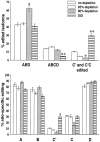Modulation of serotonin 2C receptor editing by sustained changes in serotonergic neurotransmission
- PMID: 12486144
- PMCID: PMC6758441
- DOI: 10.1523/JNEUROSCI.22-24-10529.2002
Modulation of serotonin 2C receptor editing by sustained changes in serotonergic neurotransmission
Abstract
Serotonin 2C (5-HT2C) receptor pre-mRNA is a substrate for RNA editing enzymes that convert five adenosines (named A, B, C', C, and D editing sites) to inosines. Editing of two of these sites (C' and C) is crucial for decreasing the efficiency of the receptor to activate G-protein. Nucleotide sequence analysis of mouse forebrain neocortical 5-HT2C mRNA isoforms revealed that editing at these two sites is regulated in a serotonin-dependent manner. In serotonin-depleted mice, C'- and C-site editing is significantly decreased. This results in an increased expression of 5-HT2C mRNA isoforms encoding receptors with higher sensitivity to serotonin. In contrast, a 4 d treatment with the 5-HT2A/2C agonist (+/-)-1-(4-iodo-2,5-dimethoxyphenyl)-2-aminopropane significantly increases the editing frequency at the C' site and leads to increased expression of 5-HT2C mRNA isoforms encoding receptors that activate G-protein least efficiently. None of the drug treatments led to alterations in cytoplasmic 5-HT2C mRNA levels. These data indicate that editing of 5-HT2C pre-mRNA is a mechanism that retains basic response properties of 5-HT2C receptors in the face of changing synaptic input to keep receptor activation within an optimal range for information processing. Key words: serotonin; 5.
Figures



Similar articles
-
Serotonin 2C receptors: suicide, serotonin, and runaway RNA editing.Neuroscientist. 2003 Aug;9(4):237-42. doi: 10.1177/1073858403253669. Neuroscientist. 2003. PMID: 12934707 Review.
-
Messenger RNA editing of the human serotonin 5-HT2C receptor.Neuropsychopharmacology. 1999 Aug;21(2 Suppl):82S-90S. doi: 10.1016/S0893-133X(99)00004-4. Neuropsychopharmacology. 1999. PMID: 10432493
-
How stress and fluoxetine modulate serotonin 2C receptor pre-mRNA editing.J Neurosci. 2005 Jan 19;25(3):648-51. doi: 10.1523/JNEUROSCI.3895-04.2005. J Neurosci. 2005. PMID: 15659601 Free PMC article.
-
Altered editing of serotonin 2C receptor pre-mRNA in the prefrontal cortex of depressed suicide victims.Neuron. 2002 Apr 25;34(3):349-56. doi: 10.1016/s0896-6273(02)00660-8. Neuron. 2002. PMID: 11988167
-
Identification and characterization of RNA editing events within the 5-HT2C receptor.Ann N Y Acad Sci. 1998 Dec 15;861:38-48. doi: 10.1111/j.1749-6632.1998.tb10171.x. Ann N Y Acad Sci. 1998. PMID: 9928237 Review.
Cited by
-
Reduced hypophagic effects of d-fenfluramine and the 5-HT2C receptor agonist mCPP in 5-HT1B receptor knockout mice.Psychopharmacology (Berl). 2004 Oct;176(1):39-49. doi: 10.1007/s00213-004-1864-0. Epub 2004 May 8. Psychopharmacology (Berl). 2004. PMID: 15138762
-
Mood, food, and obesity.Front Psychol. 2014 Sep 1;5:925. doi: 10.3389/fpsyg.2014.00925. eCollection 2014. Front Psychol. 2014. PMID: 25225489 Free PMC article. Review.
-
Neurobiology of stress-induced reproductive dysfunction in female macaques.Mol Neurobiol. 2008 Dec;38(3):199-230. doi: 10.1007/s12035-008-8042-z. Epub 2008 Oct 18. Mol Neurobiol. 2008. PMID: 18931961 Free PMC article.
-
ADAR2 enzymes: efficient site-specific RNA editors with gene therapy aspirations.RNA. 2022 Oct;28(10):1281-1297. doi: 10.1261/rna.079266.122. Epub 2022 Jul 21. RNA. 2022. PMID: 35863867 Free PMC article. Review.
-
Serotonergic transmission after spinal cord injury.J Neural Transm (Vienna). 2015 Feb;122(2):279-95. doi: 10.1007/s00702-014-1241-z. Epub 2014 May 28. J Neural Transm (Vienna). 2015. PMID: 24866695 Review.
References
-
- Burns C, Chu H, Rueter S, Hutchinson LK, Canton H, Sanders-Bush E, Emeson RB. Regulation of serotonin-2C receptor G-protein coupling by RNA editing. Nature. 1997;387:303–308. - PubMed
-
- Gurevich I, Tamir H, Arango V, Dwork A, Mann JJ, Schmauss C. Altered editing of serotonin 2C receptor pre-mRNA in the prefrontal cortex of depressed suicide victims. Neuron. 2002;43:349–356. - PubMed
-
- Mann JJ, Huang Y-Y, Underwood MD, Kassir SA, Oppenheim S, Kelly TM, Dwork AJ, Arango V. A serotonin transporter gene promotor polymorphism (5-HTTLPR) and prefrontal cortical binding in major depression and suicide. Arch Gen Psychiatry. 2000;57:729–738. - PubMed
Publication types
MeSH terms
Substances
Grants and funding
LinkOut - more resources
Full Text Sources
Other Literature Sources
